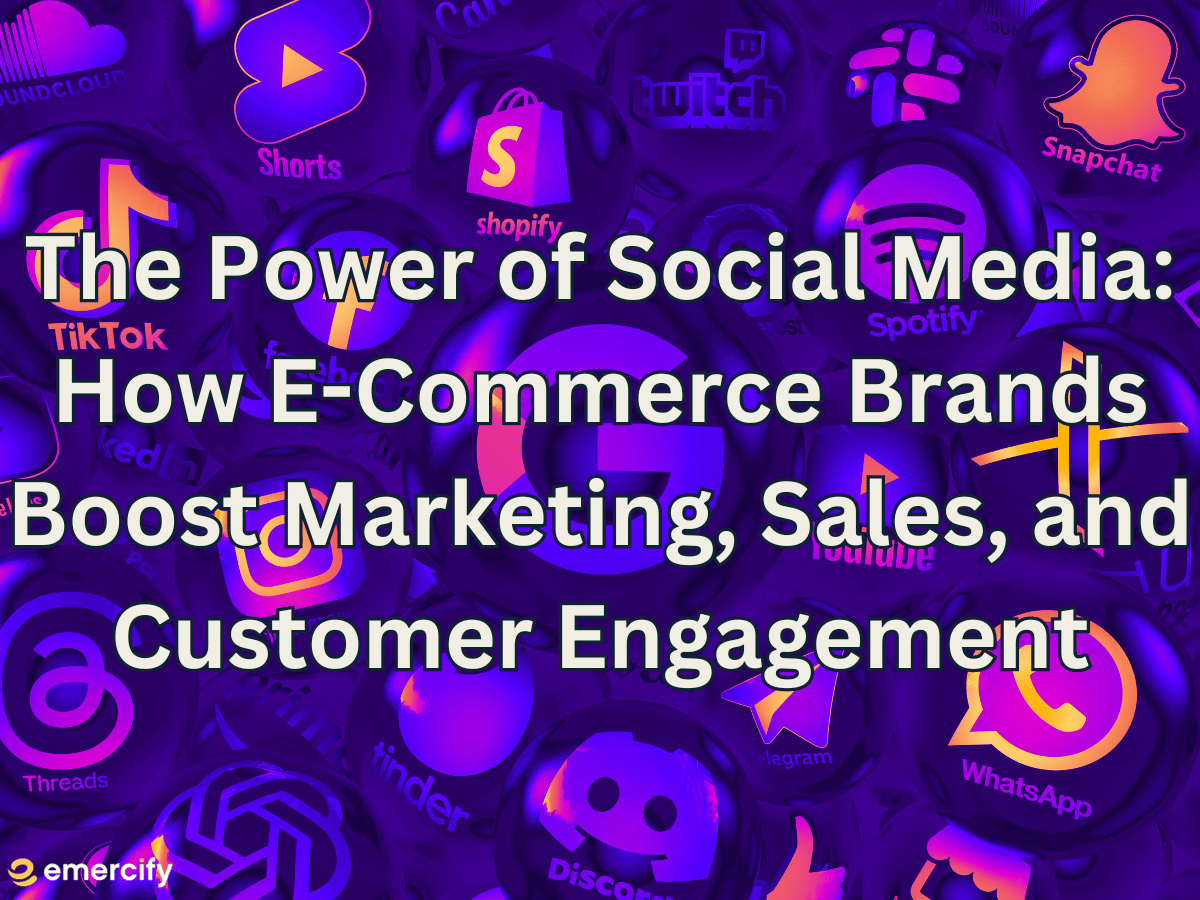Unleashing the Power of Social Media: How E-Commerce Brands Boost Marketing, Sales, and Customer Engagement

In the ever-evolving landscape of e-commerce, staying ahead of the competition requires a strategic approach to marketing, sales, and customer engagement. One of the most impactful tools at the disposal of e-commerce brands today is social media. While some owners shy away from utilizing social media to market their brands, others are embracing this type of marketing to reach their target audience and build a stronger brand presence. In this blog post, we’ll explore how savvy e-commerce businesses are leveraging social media platforms to not only increase brand visibility but also drive sales and foster meaningful customer relationships.
Building Brand Presence
Social media platforms serve as digital marketplaces where e-commerce brands can establish and strengthen their online presence. By creating engaging profiles on platforms such as Instagram, Facebook, X (Twitter), and Pinterest, brands can showcase their products in a visually appealing and relatable manner. Consistent and authentic branding across these platforms helps create a memorable and trustworthy image. Social media pages should match the overall look, feel, and messaging of your brand. You want it to be seamlessly integrated and recognizable, but you also want your social media to be true to your brand.
Targeted Advertising for Increased Sales
Social media advertising has become an integral part of e-commerce marketing strategies. With advanced targeting options, brands can reach specific demographics, interests, and behaviors, ensuring their advertisements are seen by potential customers who are most likely to convert. Platforms like Facebook and Instagram offer robust advertising tools, allowing e-commerce brands to showcase products through visually compelling ads, carousel formats, and sponsored posts. You can always start off small and use ads with a low budget, ramping up if and when you feel it necessary. A good rule of thumb is to try out an ad with a smaller budget and see how it performs. Use the data to identify trends and see what and how your next ad can work even better to reach your ideal audience. Ads are not a solution to a problem, but they do help brands extend their reach.
Engaging Content for Customer Interaction
Beyond advertising, e-commerce brands use social media to share engaging content that resonates with their target audience. This includes posts like product tutorials, behind-the-scenes glimpses, user-generated content, and compelling stories. These types of content not only keep followers interested but also encourage them to interact, comment, and share, thereby amplifying the brand's reach and fostering a sense of community. The more engagement a post can get, the more push an algorithm will give to an account so more and more of its content can reach other users. Identify the types of content your competitors are doing well, and try to replicate that. Not an identical replication, (you still need to be original), but you can try to model your posts after a competitor's posts to try and see if it will resonate well with your audience. You want to create value-based content, educational content, and engaging content. Having an overall rounded content strategy will help you build trust, authority, and engagement with your ideal community.
Influencer Partnerships
Collaborating with influencers has become a popular strategy for e-commerce brands looking to extend their reach and tap into new audiences. Influencers, with their dedicated followers, can authentically endorse products and provide social proof, influencing purchasing decisions. They share videos and photos of them reviewing, using, and trying out products, thereby getting different brands more exposure. By carefully selecting influencers aligned with a brand’s values, e-commerce businesses can leverage the trust built by these influencers to boost sales. Influencer marketing is a different type of marketing strategy entirely, but it can go hand-in-hand with social media marketing if done correctly and if it makes sense for a brand.
Social Commerce Integration
Social media platforms are increasingly becoming shopping destinations themselves. E-commerce brands are embracing features like Instagram Shopping, Facebook Marketplace, and Pinterest Shopping to facilitate seamless transactions directly on these platforms. This integration not only streamlines the customer journey but also reduces friction between product discovery and purchase, enhancing the overall shopping experience. By allowing users to shop on the platforms they are at, it makes it so much easier to get conversions. You can offer products on your social media page, and people can buy directly from there without having to shift to a different platform or website. This means you can get people to buy right then and there rather than having to have them jump through hoops to do the same. This kind of integration results in more engagement and higher conversion of sales.
Customer Feedback and Support
E-commerce brands actively utilize social media as a two-way communication channel for customer feedback, queries, and support. Timely responses to customer inquiries, addressing concerns, and acknowledging positive feedback contribute to a positive brand image. Furthermore, public interactions on social media showcase a brand's commitment to customer satisfaction, building trust and loyalty. Many social media platforms now offer the ability to automate messaging so if an inquiry comes in, you can have it set to having a thank you message send out. This type of personal touch helps in boosting trust and engagement with your brand. Often times, social media users will go to a brand’s page and message support or reach out directly onto a brand’s page if necessary to get a response. It is a good idea to have a support person (if possible) in place to answer any questions or respond to any concerns a customer may have. Good customer support goes a long way and can make or break for some people.
Social Media Marketing Helps
Social media platforms offer a multifaceted approach to marketing, sales, and customer engagement. By combining visually appealing content, targeted advertising, influencer partnerships, and seamless social commerce integration, e-commerce brands can create a comprehensive strategy that not only boosts online presence, but also drives sales, and fosters lasting customer relationships. Staying attuned to evolving social media trends and continuously adapting strategies will ensure that e-commerce brands remain at the forefront of their industry.





